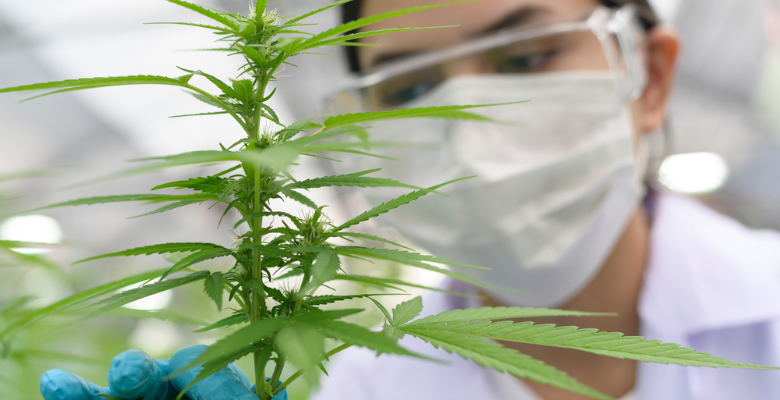Migraine, mood swings, sleep issues, hot flashes, joint pain and decreased libido are typical symptoms of menopause. A period often troubled for women, especially because there are few therapeutic resources capable of supplying this wide range of symptoms.
Although hormone replacement is helpful in this context, it is scientifically proven that this type of treatment is not recommended for women with family and personal history of breast cancer and other gynecological cancers. Medical Cannabisin turn, has proven to be a safe and effective option in combating various discomforts associated with menopause.
In this post, we will talk about the relationship between the Endocannabinoid System and the climacteric, emphasizing how phytocannabinoids can be useful in relieving symptoms and also explaining the relationship between SEC and the main gynecological cancers. Continue reading and access new possibilities with Medicine!
Phytocannabinoids in combating climacteric discomforts
The main elements of the Endocannabinoid System (ECS) are present in all female reproductive tissues, such as ovaries, fallopian tubes, endometrium and uterus. This explains the vast possibilities of interaction between phytocannabinoids and SEC to modulate climacteric symptoms, as shown below.
Mood swings
Irritability, stress and anxiety are some of the mood swings that greatly compromise the quality of life of climacteric women. Several scientific researches suggest that an assertive administration of CBD (cannabidiol) and THC (tetrahydrocannabinol) is able to significantly reduce these symptoms, producing anxiolytic effects,which minimize the body’s defensive responses in mood disorders.
>>> Check out the article here The role of cannabis in treating anxiety: an update..
Chronic pain
CBD and THC are promising agents for combating chronic pain often associated with the climacteric period, such as migraines, joint pain and fibromyalgia.
For migraine and joint pain conditions, scientific studies suggest that the main phytocannabinoids CBD and THC have relevant potential, working as important allies in opioid tapering.. This is what this this bibliographic review points out about the use of cannabinoids for combating headaches, as well as their interaction with the plant’s terpenes and flavonoids to enhance therapeutic effects.
>>> Read the study here Medicinal Properties of Cannabinoids, Terpenes, and Flavonoids in Cannabis, and Benefits in Migraine, Headache, and Pain: An Update on Current Evidence and Cannabis Science..
As for fibromyalgia, scientific research indicates promising therapeutic effects of THC in this context. A study conducted by Brazilian researchers shows that the administration of THC-rich Cannabis products for the relief of fibromyalgia symptoms provided significant improvements in the following Fibromyalgia Impact Questionnaire (FIQ)criteria: pain, sense of well-being, working and feeling fatigued.
>>> Check out here the double-blind randomized controlled trial Ingestion of a THC-Rich Cannabis Oil in People with Fibromyalgia: A Randomized, Double-Blind, Placebo-Controlled Clinical Trial..
Sleep disorders
Climacteric hot flashes are one of the main causes of sleep disorders associated with this period. As shown by several scientific studies, THC has a potential for inducing sleep and can contribute in this context, always respecting the history of each patient and individualization of dosage for each case.
>>> See the article Cannabis, Cannabinoids, and Sleep: a Review of the Literature.
Relationship between Endocannabinoid System, breast cancer and other gynecological cancers
Let’s now understand some evidence that correlates the Endocannabinoid System and the risk of climacteric cancer.
Hormone replacement and breast cancer
Although hormone replacement is a widely used treatment for combating climacteric symptoms, science has long been pointing out the risks that this treatment can bring to women who have a genetic predisposition to cancer.
An example is this research developed by scientists at Oxford University, which showed that hormone replacement therapy considerably increases the risk of developing breast cancer. According to the study, 1 out of 50 patients of hormone therapy who started at age 50 would have an increased risk of developing breast cancer between the ages of 50 to 69 after 5 years of replacement.
>>> Read the article here Type and timing of menopausal hormone therapy and breast cancer risk: individual participant meta-analysis of the worldwide epidemiological evidence
Also according to this study, covering about 108,000 women who developed the disease, those who made daily use of the combination of estrogen and progesterone for five years (one of the most common hormone replacement therapies) had an 8.3% chance of developing cancer – while the general rate of development of the disease is 6.3%, considering women in the elderly.
>>> To learn more about the study, read the article Type and timing of menopausal hormone therapy and breast cancer risk, published in the scientific journal Cancers in December 2020. The Lancet in September 2019.
The research also showed that the risk persists even in patients who abandoned replacement for more than 10 years. These data suggest how important it is to think about other therapies, in addition to hormone replacement, for combating symptoms of menopause. Medicinal Cannabis may represent a relevant therapeutic alternative in this context.
Endocannabinoid System and gynecological cancers
Although the exact causes of some gynecological cancers are still unknown, some exogenous (such as dietary pattern) and endogenous (such as genetic predisposition) factors explain the occurrence of these diseases. In 2018 alone, around 185,000 women died from ovarian cancer, 311,000 from cervical cancer, 15,000 from vulvar cancer and 8,000 from vaginal cancer.
The good news is that recent scientific research has shown that modulation of the Endocannabinoid System may be a crucial factor for the development of more effective treatments against gynecological cancers,, considering the predominance of SEC components in all female reproductive tissues.
Serum levels of endocannabinoids and the expression of endocannabinoid receptors are altered in patients with gynecological cancer. The interaction of phytocannabinoids with SEC, in turn, is able to modulate a series of aspects that contribute to this functional dysregulation in these types of cancers, as evidenced in this recent research conducted by European scientists.
The study brings together in vitro experiments relating SEC and some types of cancer, such as ovarian cancer, which has the highest mortality rate among gynecological cancers. In this experiment, the administration of cannabidiol was able to reduce from 1.35 to 1.50 times the size of tumors derived from SKOV-3, cultivated in the chorioallantoic membrane of fertilized chicken eggs.
In addition, in the experiment there was a reduction in the number of SKOV-3 ovarian cancer cells in vitro to almost zero within 48 hours, suggesting the potential of CBD in the treatment of ovarian cancer peritoneal metastases – – and possibly with fewer adverse effects than conventional treatments.
>>> To learn more about the study, read the article (Endo)Cannabinoids and Gynaecological Cancers, published in the scientific journal Cancers in December 2020. Cancers em dezembro de 2020.
Although research correlating SEC modulation and gynecological cancers still lack more expressive results, the relationship between the Endocannabinoid System and climacteric is already quite significant, with scientific evidence pointing to the benefits of cannabinoid therapy in the management of various symptoms associated with it, such a troubled period in a woman’s life.
If you want to safely, effectively and assertively incorporate cannabinoid derivatives into your therapeutic arsenal contact us and join our global community of studies in Endocannabinoid Medicine, which combines scientific knowledge and practical experience in a highly qualified manner.
References
Babson KA, Sottile J, Morabito D. Cannabis, Cannabinoids, and Sleep: a Review of the Literature. Curr Psychiatry Rep. 2017.
Baron EP. Medicinal Properties of Cannabinoids, Terpenes, and Flavonoids in Cannabis, and Benefits in Migraine, Headache, and Pain: An Update on Current Evidence and Cannabis Science.. Headache. 2018.
Chaves C, Bittencourt PCT, Pelegrini A. Ingestion of a THC-Rich Cannabis Oil in People with Fibromyalgia: A Randomized, Double-Blind, Placebo-Controlled Clinical Trial.. Pain Med. 2020.
Collaborative Group on Hormonal Factors in Breast Cancer. Type and timing of menopausal hormone therapy and breast cancer risk: individual participant meta-analysis of the worldwide epidemiological evidence. Lancet. 2019.
Taylor AH, Tortolani D, Ayakannu T, Konje JC, Maccarrone M. (Endo)Cannabinoids and Gynaecological Cancers. Cancers (Basel). 2020
Van Ameringen M, Zhang J, Patterson B, Turna J. The role of cannabis in treating anxiety: an update.. Curr Opin Psychiatry. 2020.




